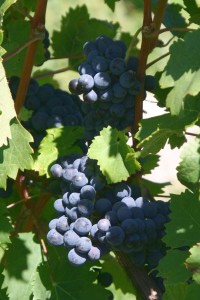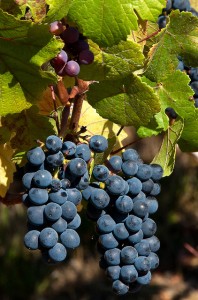A brief history of Cabernet Sauvignon, Pinor Noir, Syrah, and Merlot
If you’ve read my About page, then you know this blog is about delving into the wine and beer making process. If you haven’t then I invite you to learn more about me and my blog. Before we delve into the technicalities of making wine, I wanted to share some interesting facts I have learned about red wine. There are numerous varieties of red wine. However, there are four popular types: Cabernet Sauvignon, Pinot Noir, Syrah, and Merlot.
Cabernet Sauvignon
The cabernet sauvignon grape is small thick skinned, blue-purple with lots of seeds in proportion to its size. (Kolpan, Smith, & Weiss, 2008). There are two  main reasons that Cabernet Sauvignon continues to thrill our palates and table. The first is its ability to adapt to the soil and climate. The second is its ability to resist plant viruses and diseases. (Grumdahl, 2009) Two significant sites for Cabernet Sauvignon are Bordeaux, France and Napa Valley, California. (Kolpan, Smith, & Weiss, 2008). In France, the ancient gravel of Bordeaux holds heat, which allows the vines to stay warm while at the same time preventing the vine from truly thriving. It is the barely surviving that makes the flavor, so intense and produces the highly sought after fruit. (Kolpan, Smith, & Weiss, 2008) In California’s Napa Valley it is the ability of the rocky and volcanic soil of the alluvial fan to hold water and nutrients, which creates the signature flavor. (Kolpan, Smith, & Weiss, 2008) When it comes to bottling Cabernet Sauvignon it is rarely bottled alone. In Bordeaux, it is usually part of a team of red grapes that includes either Merlot and Cabernet Franc, or Malbec, or and Petit Verdot. (Kolpan, Smith, & Weiss, 2008) As long as 75% of the wine is Cabernet Sauvignon the label doesn’t have to list the additional wines. (Kolpan, Smith, & Weiss, 2008) Finally, the wine is aged in oak barrels, which gives it the toast, vanilla, and caramel flavors. (Kolpan, Smith, & Weiss, 2008). Cabernet Sauvignon is best recognized by its aromas of black cherries, black currants, and black olives, and black plums. (Grumdahl, 2009)
main reasons that Cabernet Sauvignon continues to thrill our palates and table. The first is its ability to adapt to the soil and climate. The second is its ability to resist plant viruses and diseases. (Grumdahl, 2009) Two significant sites for Cabernet Sauvignon are Bordeaux, France and Napa Valley, California. (Kolpan, Smith, & Weiss, 2008). In France, the ancient gravel of Bordeaux holds heat, which allows the vines to stay warm while at the same time preventing the vine from truly thriving. It is the barely surviving that makes the flavor, so intense and produces the highly sought after fruit. (Kolpan, Smith, & Weiss, 2008) In California’s Napa Valley it is the ability of the rocky and volcanic soil of the alluvial fan to hold water and nutrients, which creates the signature flavor. (Kolpan, Smith, & Weiss, 2008) When it comes to bottling Cabernet Sauvignon it is rarely bottled alone. In Bordeaux, it is usually part of a team of red grapes that includes either Merlot and Cabernet Franc, or Malbec, or and Petit Verdot. (Kolpan, Smith, & Weiss, 2008) As long as 75% of the wine is Cabernet Sauvignon the label doesn’t have to list the additional wines. (Kolpan, Smith, & Weiss, 2008) Finally, the wine is aged in oak barrels, which gives it the toast, vanilla, and caramel flavors. (Kolpan, Smith, & Weiss, 2008). Cabernet Sauvignon is best recognized by its aromas of black cherries, black currants, and black olives, and black plums. (Grumdahl, 2009)
Pinot Noir
The pinot noir is a thin, lightly colored grape prone to sunburn, over-ripen and the ability to go from under-ripen to over-ripen in one day. (Kolpan, Smith, & Weiss, 2008) Unlike cabernet sauvignon it is difficult to grow, fragile and given to mutating in the field and prone to viruses, mold, fungi, and dying. It buds early and at the mercy of spring frosts. This grape has no ideal climate, but it does grow largely in Burgundy, France and Oregon. (Kolpan, Smith, & Weiss, 2008) Another place where Pinot Noir grows well is in California, where the grapes benefit from the limestone soil, cold, fog, and intermittent sunshine. (Kolpan, Smith, & Weiss, 2008)
The making of Pinot Noir is just as difficult as the growing. High-end Pinot Noir involves hand picking grapes at night in the cold. Then transporting them to the winery in small bins where rotten and bruised grapes are removed. Next, grapes are lightly pressed and the juice is left to sit with the skins to absorb color and flavors. (Kolpan, Smith, & Weiss, 2008) High-end is bottled alone while the bottom shelf is blended with Merlot or Syrah. (Kolpan, Smith, & Weiss, 2008)
Syrah
Syrah is a dark (almost black) grape that grows anywhere in the world. There are two places in particular to the Syrah grape that are important. The first is the Rhone Valley, the original home of the grape, where the cold, rocky mountainous region creates a strong in your face flavor. The second place is the Barossa Valley in Australia, where the grapes benefits from the warmer climate, more sunlight, and the limestone and ironstone soil which creates a softer less in your face flavor. Other areas that create this same type of grape are Central California and South Africa. While Syrah is often bottled alone, depending on the producer it could be blended with another wine such as Viognier or Cabernet Sauvignon. Syrah from Australia is always blended with different varietals of wine.
 Merlot
Merlot
Merlot is a dark purple grape that originated in the Bordeaux region. The grape is known to mature quickly and turn even faster once it’s ripe. Originally its main purpose was to be used a softener to more tannic red wines such as Cabernet Sauvignon and Cabernet Franc. But over time Merlot has become recognized as a wine that should stand alone. And now it is one of the most populous wines planted around the world. Merlot is an ideal grape because it is capable of growing in colder and warmer climates. This versatility produces a variety of flavor profiles, that makes it appealing to the drinker.
Okay, enough! I’m thirsty just writing this. Red wine is a very complex wine. It is more temperamental to grow than white wine, which makes each glass even more precious. So, the next time you sit down with that glass of red wine remember it isn’t easy to get it from grape to bottle, unless its Merlot. I highly suggest checking out Drink This: Wine Made Simple by Dara Moskowitz Grumdahl. This book is a must for anyone interested in wine. Also, she’ll give you much better suggestions for putting together a home taste test of red wines. My suggestions are to try a Pinot Noir from Walla, Washington, a Syrah from Australia, and a Cabernet Sauvignon from Napa Valley. Tell me what you think!
Works Cited
Grumdahl, D. M. (2009). Drink This Wine Made Simple;. New York City: Ballantine Books.
Kolpan, S., Smith, B., & Weiss, M. (2008). WineWise: Your Complete Guide to Understanding, Selecting, and Enjoying Wine. Houghton Mifflin Harcour
[amazon_link asins=’B00EDFX2H6,0345511654,0544334620,B01FGOM68S’ template=’ProductCarousel’ store=’districtnerds-20′ marketplace=’US’ link_id=’377a464f-a4b7-11e7-ba3b-155493f53035′]







How To Throw A Wine Tasting in 3 Steps! - The District Nerd
May 30, 2019[…] something in common, like type (all rose), region (Spain or California), or varietal (Chardonnay, Pinot Noir). It’s fun to compare wines that are similar. Don’t be afraid to pick up a few of your […]